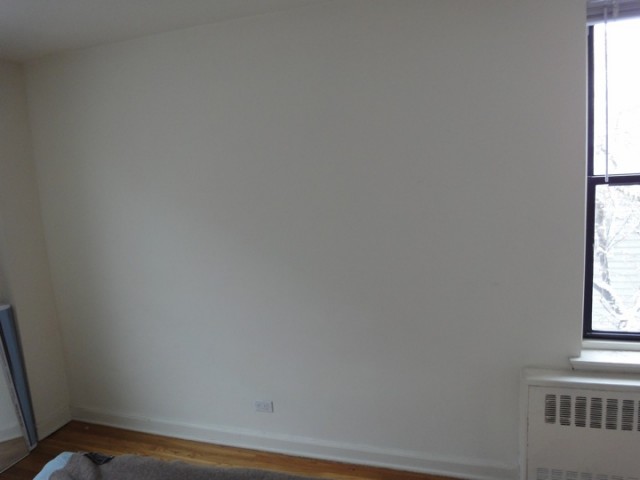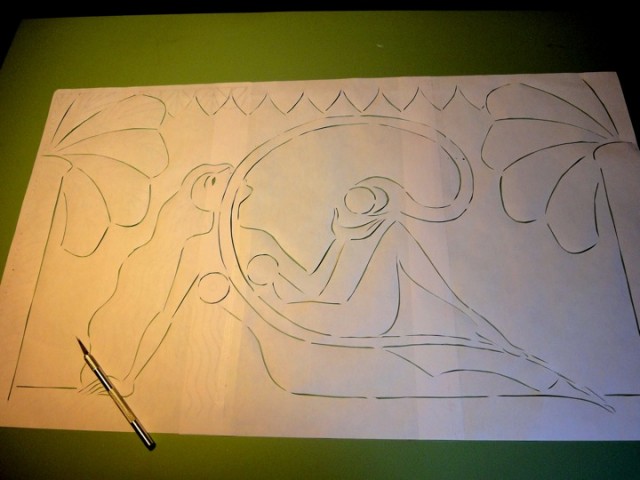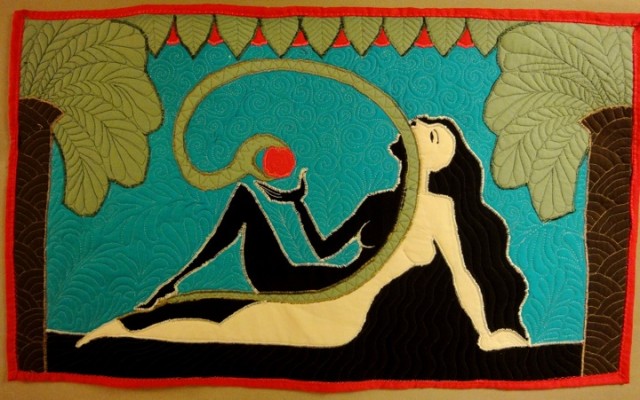w00t! I finished it! And bashed my finger with a hammer while affixing the hanging rod to the wall, so it’s painful to type. Other than that, no injuries. I present photos of my second-and-a-halfth quilt, “Earth,” which will hopefully be joined by the 3 other elements if I don’t crash out of my new sewing obsession before I make them.
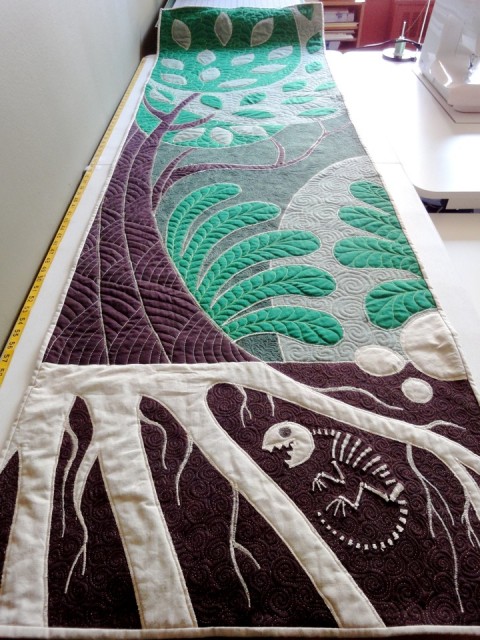 It’s a whopping 24.5″ by 79″. That’s almost 2,000 square inches! Continue reading “Earth/Tree of Life & Death”
It’s a whopping 24.5″ by 79″. That’s almost 2,000 square inches! Continue reading “Earth/Tree of Life & Death”
Month: January 2011
Piece On Earth
I have a huge bare sad wall in my bedroom.
Instead of painting it or hanging artwork, which is what a sane person would do, I decided to try using my little domestic sewing machine to make some wall hangings. Continue reading “Piece On Earth”
My second quilt/embroidery experiment
Please keep in mind I’m new at this, and am doing these to learn. I’m sharing “process” more than anything.
OK, so after my first quilt, Eve, I wanted to avoid binding (sewing an additional fabric edge around the quilt) at all costs. Binding is a huge drag and I hated doing it. But after this experiment, I will probably suffer binding again, because it allows more options than what I did here. Which was to first sew the 3 layers together (batting on the bottom) and then turn them inside out, like a pillowcase, so they were all “turned in” rather than raw at the edges when I started. I didn’t photograph that part, sorry.
Then I wanted to try my new pounce, which is an ancient image-transfer method. Unfortunately the stupid pounce wheel I bought was useless on printer paper, so I cut a stencil with an X-Acto blade.
Yes it’s the exact same design I used before. Sue me. I thought this was going to be a quickie experiment that didn’t merit designing something new. I wasn’t planning to spend 3 days on it. Oh well. Also: the back of Eve I was all messed up, and I wanted to see what it looked like if it wasn’t all wrinkled and stuff.
Anyway, the pounced work great on the stencil and the image transferred thusly: Continue reading “My second quilt/embroidery experiment”
Off The Hook
Last night I was a guest on 2600’s Off the Hook hacker radio show. I start ranting about copyright about 1/4 of the way in, and keep going until the end. Listen here.
My New Hobby
is sewing/quilting/embroidery/textile arts.
Here’s my first quilt ( a small one, 29″ x 17.5″) which I finished last night. It’s for my Momz, who requested “a nude with all the bells and whistles.”
Everything I learned from teh interwebs, which is full of quilting information and many good videos. I especially like the web site & videos of Leah Day, who makes free motion quilting look much easier than it is. Leah shares her videos and knowledge freely, which works – I’m a fan now, and spent over $250 at her online quilting store. It’s a business model I’m familiar with.
Speaking of business models, there’s an argument made by copyright advocates that no one would do anything creative without monetary (or monopoly) incentives:

My past few weeks exploring quilting confirms this is absolutely not true. In less than a month of getting myself set up with a sewing machine, fabric, threads, and other supplies, I’ve probably shelled out $1,000. It started with an inexpensive sewing machine ($250), but then I needed special feet for it, and cutters, and an iron, and pins, and threads, and batting, and fabric, and a sewing table, and IKEA drawers to hold all this stuff, and on and on. And that was being budget-conscious; I could easily spend a lot more. In fact I really, really want a longer machine with more space under the arm; unfortunately those cost about $3,000.
I’m not alone: tens if not hundreds of thousands of Americans pay for the privilege to create, not the other way around. Most quilters are not paid; most actually give their work away, to family, friends and charities. That’s folk art, people: it’s not done for money. And yes, it is art.
It’s very much like filmmaking, which is now a folk art.
“The film business has never been a business. It’s always been a hobby.” –someone whose name I don’t remember at a film conference I attended last year
Even setting aside independent film productions, which are hobbies in business clothing, most people spend more on video cameras and computers than they’ll ever get back selling their work. With the spread of cheap animation software, animation is now a folk art too. With the rise of print-on-demand self-publishing, novel-writing is also becoming folk art (Pirates of Savannah by Tarrin Lupo is what I’d call a folk art novel). All the super-elite arts of the 20th Century are becoming folk art.
Would I still like to make money with this? Yes, I would. But I’ve already spent plenty of money with no promise of monetary return. It’s been worth it so far, because learning has been exhilarating. Hopefully traditional folk arts, like quilting, will continue to gain respect as “real” art, even as “real” arts are adopted by the masses. I confess I would like to sell original pieces, if I keep making them. It’s really up to my Muse.
After the jump are some pictures of the making of “Eve,” which took 3 days (4 if you include the day I designed it):
Spiral In, Spiral Out
I’ve been drawing for so long, I forget what it feels like to learn how to draw. But once in a while, I learn something really basic for the first time. I wanted to write about it before I forget what it feels like.
The topic: spirals. I love ’em. I used ’em for clouds in Sita Sings the Blues:
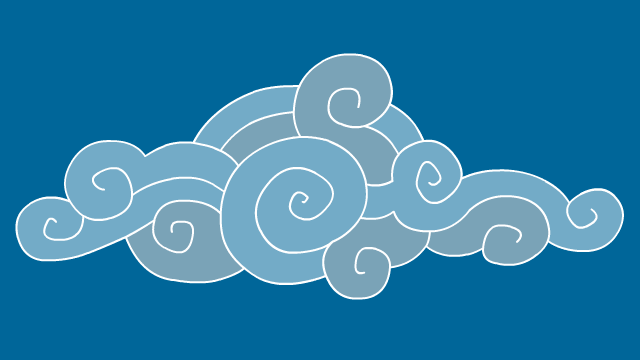
And for ocean waves in my fake-Moghul-minature style:
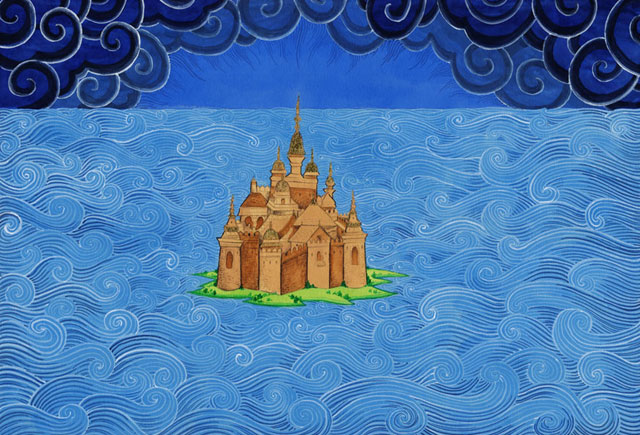
Now, I believe I can draw anything. That doesn’t mean I can just sit down and draw anything off the top of my head. What it really means is I can copy anything. Everything in my drawing memory banks originated from copying one thing or another at one time (notice how I used “originated” and “copying” in the same sentence). Everything I copy is stored somewhere in my head, and my muscles too – actually moving my hand around a shape forms my mind in a way that just looking doesn’t.
I’ve looked at a lot of pictures of Tibetan-style clouds. Some of these showed up in Indian art, in the Adventures of Hamzaa, the beautiful catalogue of which I owned until I left it behind with the bed bugs. Apparently Moghuls imported artists from all over Asia, which is why some Moghul miniatures are beautiful mish-mashes of Persian and Himalayan styles.
I saw the spirals in those cloud designs, so I drew clouds with spirals. They didn’t really look the same, which was fine – I wasn’t copying directly, merely being “influenced.” I made do with the spiral-drawing skills I had.
Fast-forward to today, and my new hobby: sewing. It turns out you can draw with an ordinary sewing machine! It’s called “free motion,” and I only learned it was possible last month. A few weeks ago I bought a machine and fabric and stuff, beginning another kind of spiral that’s taking over my life & apartment (more on that later). Drawing with a sewing machine is different from drawing conventionally in 2 significant ways:
- The “pen” stays still and you move the “paper” (fabric) around.
- You can’t lift the pen. It stays down the whole time.
#1 is simple in theory, but difficult in practice as I need to retrain my muscles. It’s like holding a pen for the first time, or drawing with my feet. I’m clumsy, for sure.
#2 seems simple – after all, isn’t drawing intricate designs with long meandering continuous lines what every stoned college kid does? Well, I haven’t been a college kid for 23 years, and I don’t get stoned (my few experiences with pot didn’t go very well). I never thought about how much I lift my pen. I usually draw with a lot of short strokes. I had to get in the stoned-doodling-college-kid mindset and keep my pen down.
I thought the cloud designs from SSTB would look nice quilted, so I used one in this, my first Trapunto experiment (more after the jump):
Continue reading “Spiral In, Spiral Out”

